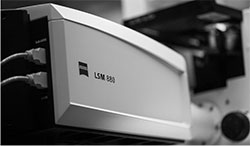Jie Zheng, Ph.D.

Professor
4145 Tupper Hall
Davis Campus
530-752-1241
jzheng@health.ucdavis.edu
Lab Website
Research Interests
Molecular mechanisms of ion channel function. Using novel fluorescence techniques in the combination with electrophysiology, molecular biology, and biochemistry to better understand ion channel structure and its dynamic rearrangements the underlie channel function in cellular signal transduction.
Ion channels form the basis of electrical excitability of neurons and muscle cells. In response to specific electrical or chemical stimuli, these membrane proteins open a pathway across the cell membrane for selected ions, causing changes in membrane potential or intracellular levels of calcium. Activation of an ion channel is under extremely precise control that allows highly specialized processes, e.g., photoreceptor cells to detect the presence of a single photon. Research in my laboratory focuses on the protein structures critical for channel organization, activation, and modulation. The moving parts of the channel are labeled with fluorophores that serve as a molecular sensor for local conformational rearrangements. Recording the fluorescence emission let us directly observe channel structural changes in real time under physiological conditions. The same population of channels is simultaneously monitored with patch-clamp recordings so that we can correlate structure changes to the channel's function states. In particular, we use Fluorescence Resonance Energy Transfer (FRET) to measure atomic distances between channel structures.
Graduate Group Affiliations
An updated list of current publications: Google Scholar
Zhao, F., S. Wang, Y. Li, J. Wang, Y. Wang, C. Zhang, Y. Li, L. Huang, Y. Yu, B. Yu, J. Zheng, I. Pessah, Z. Cao (2021) “Surfactant cocamide monoethanolamide causes eye irritation by activating nociceptor TRPV1”, British Journal of Pharmacology, (in press)
Liu, C., R. Reese, S. Vu, L. Rougé, S. Shields, H. Chen, Y. Shi, T. Chernov-Rogan, K. Johnson, D.M.Z. Greiner, P.B. Kohli, D. Hackos, S. Kakiuchi-Kiyota, B. Brillantes, C. Tam, T. Li, J. Wang, S. Magnuson, M. Volgraf, J. Payandeh, J. Zheng, A. Rohou and J. Chen (2021) “A non-covalent ligand reveals biased agonism at the TRPA1 ion channel”, Neuron, 109(2):273-284.e4. doi: 10.1016/j.neuron.2020.10.014.
Vu, S., V. Singh, H. Wulff, V. Yarov-Yarovoy, J. Zheng (2020) “New capsaicin analogs as molecular rulers to define the permissive conformation of the mouse TRPV1 ligand-binding pocket”, eLife, 9:e62039. DOI: https://doi.org/10.7554/eLife.62039
Yang, F.¶, L. Xu, B.H. Lee, X. Xiao, V. Yarov-Yarovoy, J. Zheng¶ (2020) “An unorthodox mechanism underlying voltage sensitivity of TRPV1 ion channel”, Advanced Science, 2000575. DOI: 10.1002/advs.202000575
Du, G., Y. Tian, Z. Yao, S. Vu, J. Zheng, L. Chai, K. Wang, S. Yang (2020) “A specialized pore turret in the mammalian cation channel TRPV1 is responsible for distinct and species-specific heat activation thresholds”, Journal of Biological Chemistry, 295(28):9641-9649; DOI: 10.1074/jbc.RA120.013037
Zhu, A., A. Aierken, Z. Yao, S. Vu, Y. Tian¶, J. Zheng¶, S. Yang¶, F. Yang¶ (2020) “A centipede toxin causes rapid desensitization of nociceptor TRPV1 ion channel”, Toxicon, 178:41-49; DOI:10.1016/j.toxicon.2020.02.016
Yao, Z., P.M. Kamau, Y. Han, J. Hu, A. Luo, L. Luo¶, J. Zheng¶, Y. Tian¶, R. Lai¶ (2019) “The Latoia consocia caterpillar induces pain by targeting nociceptive ion channel TRPV1”, Toxins, 11: 695; DOI:10.3390/toxins11120695
6. Dong, Y., Y. Yin, S. Vu, F. Yang, V. Yarov-Yarovoy, Y. Tian¶, J. Zheng¶ (2019) “A distinct structural mechanism underlies TRPV1 activation by piperine”, Biochemical and Biophysical Research Communications, 516: 365-372 DOI: 10.1016/j.bbrc.2019.06.039
Yin, Y., Y. Dong, S. Vu, F. Yang, V. Yarov-Yarovoy, Y. Tian¶, J. Zheng¶ (2019) Structural Mechanism Underlying TRPV1 Activation by Pungent Compounds in Gingers, British Journal of Pharmacology, 176: 3364–3377. DOI: 10.1111/bph.14766
Luo, L., Y. Wang, B. Li, L. Xu, P.M. Kamau, J. Zheng¶, F. Yang¶, S. Yang¶, R. Lai¶ (2019) “Molecular Basis for Heat Desensitization of TRPV1 Ion Channels”, Nature Communications, 10:2134 (¶ corresponding authors)
Wang, H., Z. Xu, B.H. Lee, S. Vu, L. Hu, M. Lee, D. Bu, X. Cao, S. Hwang, Y. Yang, J. Zheng¶, Z. Lin¶ (2018) “Gain-of-function mutations in TRPM4 activation gate cause progressive symmetric erythrokeratoderma”, Journal of Investigative Dermatology, 139:1089-1097 (¶ corresponding authors)
Yang, F., X. Xiao, B.H. Lee, S. Vu, W. Yang, V. Yarov-Yarovoy, J. Zheng (2018) “The conformational wave in capsaicin activation of transient receptor potential vanilloid 1 ion channel”, Nature Communications,9:2879 | DOI: 10.1038/s41467-018-05339-6
Han, Y., B. Li, T. Yin, C. Xu, R. Ombati, L. Luo, Y. Xia, L. Xu, J. Zheng, Y. Zhang, F. Yang, G. Wang, S. Yang, R. Lai (2018) “Molecular mechanism of tree shrew’s insensitivity to pungency”, PLoS Biology, 16(7): e2004921.
Yang, S., F. Yang, B. Zhang, B.H. Lee, B. Li, L. Luo, J. Zheng¶, and R. Lai¶ (2017) “A novel bi-modal activation mechanism underlies scorpion toxin induced pain”, Science Advances, 3: e1700810 (¶ corresponding authors)
*** The paper by Yang, S., F. Yang, et al.(2017) is highlighted by Discover Magazine.
Yang, F., and J. Zheng (2017) “Understand spiciness: mechanism of TRPV1 channel activation by capsaicin”, Protein & Cell, 8(3):169-177
He, X. C. Shen, Q. Lu, J. Li, Y. Wei, L. He, R. Bai, J. Zheng, N. Luan, Z. Zhang, M. Rong, R. Lai (2016) “Prokineticin 2 Plays a Pivotal Role in Psoriasis”, EBioMedicine, DOI: 10.1016/j.ebiom.2016.10.022
Ma, L., F. Yang, S. Vu, and J. Zheng (2016) “Exploring functional roles of TRPV1 intracellular domains with unstructured peptide-insertion screening”, Scientific Reports, 6:33827, DOI: 10.1038/srep33827
Kim, S., D. Barry, X.Y. Liu, S. Yin, A. Munanairi, Q.T. Meng, W. Cheng, P. Mo, L. Wan, S.B. Liu, K. Ratnayake, Z. Q. Zhao, N. Gautam, J. Zheng, W.K.A. Karunarathne, and Z. F. Chen (2016) “Facilitation of TRPV4 by TRPV1 is required for itch transmission in some sensory neuron populations”, Science Signaling, 9(437): ra71
Yang, F., S. Vu, V. Yarov-Yarovoy, and J. Zheng (2016) “Rational design and validation of a vanilloid-sensitive TRPV2 ion channel”, Proceedings of the National Academy of Sciences, USA, E3657–E3666
Simonov, A.N., J.K. Holien, J.C.I. Yeung, A.D. Nguyen, C.J. Corbin, J. Zheng, V.L. Kuznetsov, R.J. Auchus, A.J. Conley, A.M. Bond, M.W. Parker, R.J. Rodgers, L.L. Martin (2015) “Mechanistic scrutiny identifies a kinetic role for cytochrome b5 regulation of human cytochrome P450c17”, PLoS One, 10(11): e0141252
Yang, S., F. Yang, N. Wei, J. Hong, B. Li, L. Luo, M. Rong, V. Yarov-Yarovoy, J. Zheng¶, K.W. Wang¶, R. Lai¶ (2015) “A pain-inducing centipede toxin targets the heat activation machinery of nociceptor TRPV1”, Nature Communication, 6:8297 (¶ corresponding authors)
Lee, B.H., and J. Zheng (2015) “Proton block of proton-activated TRPV1 current”, Journal of General Physiology, 146(2):147-159
Yang, F., X. Xiao, W. Cheng, W. Yang, P. Yu, Z. Song, V. Yarov-Yarovoy, J. Zheng (2015), “Structural mechanism underlying capsaicin binding and activation of nociceptive TRPV1 ion channel”, Nature Chemical Biology, 11:518–524.
“![]() ” Jie Zheng and Matthew C. Trudeau (editors), (2015) “Handbook of Ion Channels”, CRC Press.
” Jie Zheng and Matthew C. Trudeau (editors), (2015) “Handbook of Ion Channels”, CRC Press.
** Review by Richard Aldrich (2015) A new standard: a review of Handbook of Ion Channels, Journal of General Physiology, 146(2):119-121a,
** Review by David R. Harder (2015) Physiologist, 58(4):205-208
** Review by Bingcai Guan, Zuan Zhou, Hailin Zhang (2015) Acta Physiologica Sinica, 67(5)
Clifton, H.L., B. Inceoglu, L. Ma, J. Zheng, S. Schaefer (2015) “TRPV1 Channels are Involved in Niacin-induced Cutaneous Vasodilation in Mice”, Journal of Cardiovascular Pharmacology, 65(2):184-191
Ma, L., B.H. Lee, H. Clifton, S. Schaefer, and Jie Zheng (2015) “Nicotinic acid is a common regulator of heat-sensing TRPV1-4 ion channels”, Scientific Reports, 5:8906; DOI:10.1038/srep08906
Zheng, J., X. Zeng, and S. Wang (2015) “Calcium as cellular messenger”, Science China Life Sciences, 58(1):1-5
Zheng, J. and L. Ma (2014) “Structure and Function of the ThermoTRP Channel Pore”, in L. D. Islas, & F. Qin (Eds.), Thermal Sensors, 233-257
Tang, Y.Q., J.H. Zhou, F. Yang, J. Zheng, and K.W. Wang (2014) “The tetramerization domain potentiates Kv4 channel function by suppressing closed-state inactivation”, Biophysical Journal, 107: 1090-1104
Yang, F., and J. Zheng (2014) “High temperature sensitivity is intrinsic to voltage-gated potassium channels”, eLife, e03255.
- MCP210A, Advanced Physiology, Co-Instructor of Record
- MCP210L, Lab Rotation, Co-Instructor of Record
- PTX202, Principles of Pharmacology: Cellular and Molecular Basis of Drug Action
- HPH400, Medical Human Physiology
- MCP216, Neurophysiology
- MCP209, Seminar on Frontiers in Neurobiology
- HPH199, Special Study
- HPH299, Research
- MCP-BPH241, Membrane Biology
- BPH200B, Techniques in Biophysics
- The Grass Foundation Traveling Scientist Award. 2009




 Make a donation using our secure online system.
Make a donation using our secure online system.